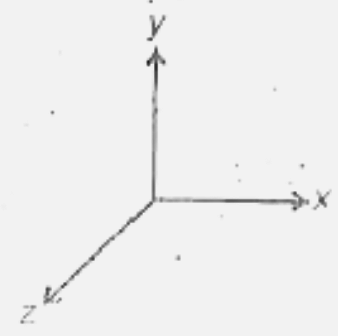A : The poynting vector given as ¯¯¯S=¯¯¯Eׯ¯¯Bμ0 represents the instantaneous intensity at a point.
R : The velocity of an electromagnetic wave is in the direction of the vector ¯¯¯Eׯ¯¯B.
If both Assertion & Reason are true and the reason is the correct explanation of the assertion, then mark (1)
If both Assertion & Reason are true but the reason is not the correct explanation of the assertion, then mark (2)
If assertion is true statement but Reason is false, then mark (3)
If both Assertion and Reason are false statements, then mark (4)
The correct Answer is:B
To solve the assertion-reason question, we will analyze both the assertion (A) and the reason (R) step by step.
Step 1: Understanding the Poynting Vector
The Poynting vector ¯S is defined as:
¯S=¯EׯBμ0
where ¯E is the electric field vector, ¯B is the magnetic field vector, and μ0 is the permeability of free space. The Poynting vector represents the directional energy flux, or the energy per unit area per unit time, of an electromagnetic wave.
Step 2: Direction of the Poynting Vector
The direction of the Poynting vector ¯S is given by the cross product ¯EׯB. The direction of this vector indicates the direction in which energy is flowing.
Step 3: Relationship Between ¯E, ¯B, and Wave Propagation
For electromagnetic waves, the direction of propagation is given by the vector ¯EׯB. This means that the wave travels in the direction of the Poynting vector, which is also the direction of the cross product ¯EׯB.
Step 4: Analyzing the Assertion (A)
The assertion states that the Poynting vector represents the instantaneous intensity at a point. This is correct because the Poynting vector indeed quantifies the energy flow per unit area, which can be interpreted as intensity.
Step 5: Analyzing the Reason (R)
The reason states that the velocity of an electromagnetic wave is in the direction of the vector ¯EׯB. This is also correct, as the direction of wave propagation is aligned with the direction of the Poynting vector, which is given by the cross product of the electric and magnetic fields.
Step 6: Conclusion
Both the assertion and the reason are correct. However, the reason does not serve as a direct explanation for the assertion since the assertion is based on the definition of the Poynting vector, while the reason describes the direction of wave propagation.
Final Answer
- Assertion (A) is correct.
- Reason (R) is correct.
- However, (R) is not the correct explanation for (A).
The Poynting vector ¯S is defined as:
¯S=¯EׯBμ0
where ¯E is the electric field vector, ¯B is the magnetic field vector, and μ0 is the permeability of free space. The Poynting vector represents the directional energy flux, or the energy per unit area per unit time, of an electromagnetic wave.
The direction of the Poynting vector ¯S is given by the cross product ¯EׯB. The direction of this vector indicates the direction in which energy is flowing.
For electromagnetic waves, the direction of propagation is given by the vector ¯EׯB. This means that the wave travels in the direction of the Poynting vector, which is also the direction of the cross product ¯EׯB.
The assertion states that the Poynting vector represents the instantaneous intensity at a point. This is correct because the Poynting vector indeed quantifies the energy flow per unit area, which can be interpreted as intensity.
The reason states that the velocity of an electromagnetic wave is in the direction of the vector ¯EׯB. This is also correct, as the direction of wave propagation is aligned with the direction of the Poynting vector, which is given by the cross product of the electric and magnetic fields.
Both the assertion and the reason are correct. However, the reason does not serve as a direct explanation for the assertion since the assertion is based on the definition of the Poynting vector, while the reason describes the direction of wave propagation.
- Assertion (A) is correct.
- Reason (R) is correct.
- However, (R) is not the correct explanation for (A).
Topper's Solved these Questions
- ELECTROMAGNETIC WAVESBook:AAKASH INSTITUTEChapter:ELECTROMAGNETIC WAVESExercise:ASSIGNMENT SECTION - C Previous Years Questions
Explore 22 Videos
- ELECTROMAGNETIC INDUCTIONBook:AAKASH INSTITUTEChapter:ELECTROMAGNETIC INDUCTIONExercise:ASSIGNMENT(SECTION -D) Assertion-Reason type Question)
Explore 15 Videos
- ELECTROSTATIC POTENTIAL AND CAPACITANCE Book:AAKASH INSTITUTEChapter:ELECTROSTATIC POTENTIAL AND CAPACITANCE Exercise:ASSIGNMENT SECTION - D
Explore 13 Videos
Similar Questions
If ¯a is a unit vector then ¯a×{¯a×(¯aׯb)=
View SolutionIf ¯a is a unit vector then ¯a×{¯a×(¯aׯb)}
View SolutionThree vectors bar(P) bar(Q) and bar(R) are shown in the figure.Let S be any point on the vector bar(R) .The distance between the points P and S is b|bar(R)| .The general relation among vectors bar(P) bar(Q) and bar(s) is
View SolutionThree vectors ¯¯¯P,¯¯¯Qand¯¯¯R are shown in the figure.Let S be any point on the vector bar(R) .The distance between the points P and S is b|bar(R)| .The general relation among vectors bar(P) bar(Q) and bar(S) is qquad Y
View SolutionIf the vector −¯i+¯j−¯k bisects the angles between the vector ¯c and the vector 3¯i+4¯j ,then the unit vector in the direction of ¯c is
View SolutionIf ∣∣¯a.¯b∣∣=∣∣¯aׯb∣∣&¯a.¯b<0, then find the angle between ¯aand¯b.
View SolutionThe value of (¯¯¯A+¯¯¯B)×(¯¯¯A−¯¯¯B) is
View SolutionIf ¯¯¯Aand ¯¯¯Bare two vectors then A new vector parallel to ¯¯¯Ahaving the magnitude of ¯¯¯Bis
View SolutionLight wave travelling along y-direction. If the corresponding ¯¯¯E vector at any time along x-axis, the direction of ¯¯¯B vector at that time is along

View SolutionGiven vectors ¯¯¯CB=¯a,¯¯¯CA=¯band¯¯¯CO=¯x where O is the centre of circle circumscribed about ΔABC, then find vector ¯x
View Solution

